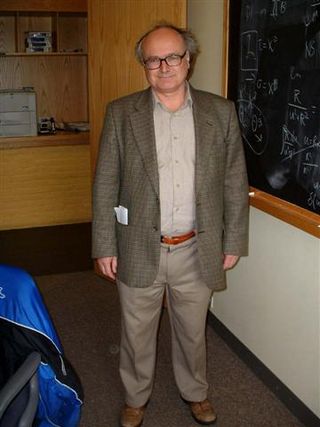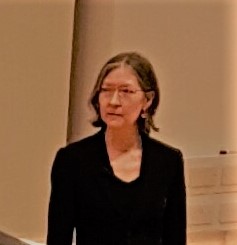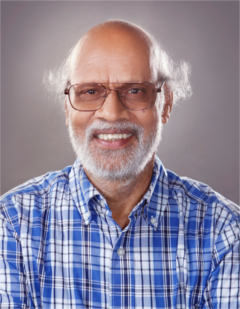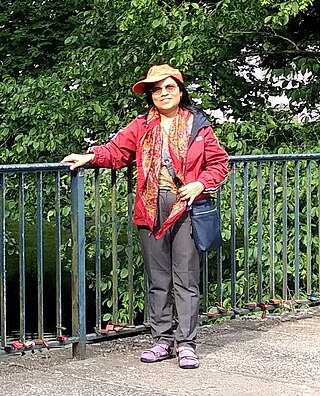In physics, the fundamental interactions or fundamental forces are the interactions that do not appear to be reducible to more basic interactions. There are four fundamental interactions known to exist:
M-theory is a theory in physics that unifies all consistent versions of superstring theory. Edward Witten first conjectured the existence of such a theory at a string theory conference at the University of Southern California in 1995. Witten's announcement initiated a flurry of research activity known as the second superstring revolution. Prior to Witten's announcement, string theorists had identified five versions of superstring theory. Although these theories initially appeared to be very different, work by many physicists showed that the theories were related in intricate and nontrivial ways. Physicists found that apparently distinct theories could be unified by mathematical transformations called S-duality and T-duality. Witten's conjecture was based in part on the existence of these dualities and in part on the relationship of the string theories to a field theory called eleven-dimensional supergravity.
In physics, string theory is a theoretical framework in which the point-like particles of particle physics are replaced by one-dimensional objects called strings. String theory describes how these strings propagate through space and interact with each other. On distance scales larger than the string scale, a string looks just like an ordinary particle, with its mass, charge, and other properties determined by the vibrational state of the string. In string theory, one of the many vibrational states of the string corresponds to the graviton, a quantum mechanical particle that carries the gravitational force. Thus, string theory is a theory of quantum gravity.

A theory of everything (TOE), final theory, ultimate theory, unified field theory or master theory is a hypothetical, singular, all-encompassing, coherent theoretical framework of physics that fully explains and links together all aspects of the universe. Finding a theory of everything is one of the major unsolved problems in physics.
A wormhole is a hypothetical structure connecting disparate points in spacetime, and is based on a special solution of the Einstein field equations.

Andrew Eben Strominger is an American theoretical physicist who is the director of Harvard's Center for the Fundamental Laws of Nature. He has made significant contributions to quantum gravity and string theory. These include his work on Calabi–Yau compactification and topology change in string theory, and on the stringy origin of black hole entropy. He is a senior fellow at the Society of Fellows, and is the Gwill E. York Professor of Physics.
The chronology protection conjecture is a hypothesis first proposed by Stephen Hawking that laws of physics beyond those of standard general relativity prevent time travel on all but microscopic scales - even when the latter theory states that it should be possible. The permissibility of time travel is represented mathematically by the existence of closed timelike curves in some solutions to the field equations of general relativity. The chronology protection conjecture should be distinguished from chronological censorship under which every closed timelike curve passes through an event horizon, which might prevent an observer from detecting the causal violation.

Lisa Randall is an American theoretical physicist and Frank B. Baird, Jr. Professor of Science at Harvard University. Her research includes the fundamental forces of nature and dimensions of space. She studies the Standard Model, supersymmetry, possible solutions to the hierarchy problem concerning the relative weakness of gravity, cosmology of dimensions, baryogenesis, cosmological inflation, and dark matter. She contributed to the Randall–Sundrum model, first published in 1999 with Raman Sundrum.
Fuzzballs are hypothetical objects in superstring theory, intended to provide a fully quantum description of the black holes predicted by general relativity.

Gary William Gibbons is a British theoretical physicist.
An exotic star is a hypothetical compact star composed of exotic matter, and balanced against gravitational collapse by degeneracy pressure or other quantum properties.

Physics beyond the Standard Model (BSM) refers to the theoretical developments needed to explain the deficiencies of the Standard Model, such as the inability to explain the fundamental parameters of the standard model, the strong CP problem, neutrino oscillations, matter–antimatter asymmetry, and the nature of dark matter and dark energy. Another problem lies within the mathematical framework of the Standard Model itself: the Standard Model is inconsistent with that of general relativity, and one or both theories break down under certain conditions, such as spacetime singularities like the Big Bang and black hole event horizons.

Helen Fay Dowker is a British physicist who is a current professor of theoretical physics at Imperial College London.
In physics the Einstein-aether theory, also called aetheory, is the name coined in 2004 for a modification of general relativity that has a preferred reference frame and hence violates Lorentz invariance. These generally covariant theories describes a spacetime endowed with both a metric and a unit timelike vector field named the aether. The aether in this theory is "a Lorentz-violating vector field" unrelated to older luminiferous aether theories; the "Einstein" in the theory's name comes from its use of Einstein's general relativity equation.

Superfluid vacuum theory (SVT), sometimes known as the BEC vacuum theory, is an approach in theoretical physics and quantum mechanics where the fundamental physical vacuum is considered as a superfluid or as a Bose–Einstein condensate (BEC).
Ruth Ann Watson Gregory is a British mathematician and physicist, currently Head of Department of Physics and Professor of Theoretical Physics at King's College London. Her fields of specialisation are general relativity and cosmology.

Daya Shankar Kulshreshtha is an Indian theoretical physicist, specializing in formal aspects of quantum field theory, string theory, supersymmetry, supergravity and superstring theory, Dirac's instant-form and light-front quantization of field theories and D-brane actions. His work on the models of gravity focuses on the studies of charged compact boson stars and boson shells.
Gerhard Drolshagen is a German physicist at the University of Oldenburg, Germany, specializing in space environment and near-Earth objects (NEO). He has been a staff member at the European Space Agency (ESA), European Space Research and Technology Centre (ESTEC), Noordwijk, The Netherlands (1987–2016) and is known for his work in space environment, NEO and for the asteroid named after him: the asteroid 332733 Drolshagen.

Usha Kulshreshtha is an Indian theoretical physicist, specializing in the Dirac's instant-form and light-front quantization of quantum field theory models, string theory models and D-brane actions using the Hamiltonian, path integral and BRST quantization methods, constrained dynamics, construction of gauge theories and their quantizaton under gauge-fixing as well as study of boson stars, and wormholes in general relativity and gravity theory.






